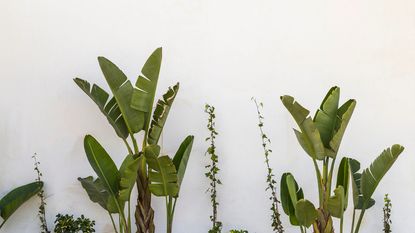Growing Banana Trees


The popularity of banana plants is growing, and they are now popular in countries where they don't naturally grow. This is no surprise because this group of tropical plants are beautiful. Banana trees are one of the more common trees that come to mind when one is dreaming of the tropics. However, did you know that they are not really trees? They are actually the world's largest herbs. Still, due to their size and appearance they are they have become commonly known and thought of as banana "trees". The banana is in the same order of plants as the Strelitzia, Ravenala and Canna genera which you may be familiar with. The scientific name for the banana genus is Musa. This article provides an overview of the basics of caring for banana plants. Of course, the care required for different species may vary slightly. Anatomy First let us get familiar with the morphology of this plant. Banana plants have a pseudostem, and new leaves will be pushed up from the middle of this. These new leaves are rolled up, and they will unroll when the whole leaf has emerged. Most of the older leaves on a banana plant are torn because the leaves are very thin, and even the wind can blow holes in them. Banana plants have rhizomes, and from these many new shoots appear. You can cut these off the 'mother plant' and can be potted on.
A frequently asked question is "Will there be real bananas on this tree?". After three or four years a banana tree will flower and then you will get bananas that you can eat The biggest challenge with this plant, when not growing it in the tropics, is how to protect it in winter.
Maintenance
Heat
Warmth is necessary for optimal growth. There are also banana plants available that will grow in the cold, but below five degrees they will also stop growing. Below minus two degrees the leaves will die but the roots will still be alive. Popular species for cold climates: Musa basjoo: can survive until -20 C Musa sikkimensis: can survive until -15 C Musella lasiocarpa: can survive until -5 C
Light
A warm environment is not all that is required - banana plants also need a lot of light. If you have a banana indoors you need to make sure that it is near the window, but avoid direct sunlight because this will burn the leaves.
Gardening tips, videos, info and more delivered right to your inbox!
Sign up for the Gardening Know How newsletter today and receive a free download of our most popular eBook "How to Grow Delicious Tomatoes."
Water
Of course after heat and light you need to consider water - banana plants need lots of water. On hot summer days they can require up to 10 liters of water. But be careful that the roots aren't sitting in water, because these plants are infamous for developing root rot. During the colder season, less water is necessary.
Fertilizer
Banana plants can grow very fast, especially if you fertilize them correctly. It's almost impossible to give too much fertilizer to a banana, but of course in the cold months the fertilizer must be minimized to discourage growth.
Pruning
You don't need to prune bananas but for aesthetic reasons you can remove the old leaves. You can also remove the plantlet If your banana has frost damage, you can cut off the damaged part of the trunk and most of the time it will grow again. When you cut away the damage you must remove a large part of the trunk to encourage regrowth.
Diseases
Basically, banana plants are not very susceptible to pests or diseases. Most problems will arise in the winter time. The most common issues are spider mites, aphids or root rot from soil that is too wet. For the first two issues you should use the most appropriate treatment as soon as possible. For example, a suitable pest control product. Rotting can only be prevented by ensuring a dry root ball. It is best to cut away any rotten parts before allowing the root ball to dry out. I
nteresting Facts
- Bananas can be found in colors other than yellow, including red.
- Most species of banana plant originated in Southeast Asia.
- A row of bananas is sometimes called a 'hand', while a single banana is called a 'finger'.
- Banana fruit consists of around 75% water.
- The Gros Michel banana was a popular variety before crops were destroyed by Panama disease in the 1950's. Panama disease attacks the roots of banana plants.
- The most popular type of banana sold in stores these days is the Cavendish banana. It is resistant to the strain of Panama disease that effectively wiped out the Gros Michel banana but there are concerns that it too may eventually suffer a similar fate.
- Lady Finger bananas are small, sweet and have relatively thin skins.
- Wild bananas grow large, hard seeds.
- India is the leading producer of bananas.
-
 How To Grow Garden To Table: A Guide For Home Cooks
How To Grow Garden To Table: A Guide For Home CooksWhat could be better than a meal that comes directly from garden to table? Show off your gardening and culinary skills with the very freshest food.
By Bonnie L. Grant
-
 Want a Backyard Mini Orchard? Create Your Own Container Orchard
Want a Backyard Mini Orchard? Create Your Own Container OrchardEasier to care for in small spaces, a backyard mini-orchard makes sense for busy gardeners and juicy fruit is the reward.
By Teo Spengler